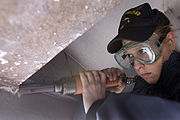
Needlegun scaler
Encyclopedia

Rust
Rust is a general term for a series of iron oxides. In colloquial usage, the term is applied to red oxides, formed by the reaction of iron and oxygen in the presence of water or air moisture...
, mill scale
Mill scale
Mill scale, often shortened to just scale, is the flaky surface of hot rolled steel, iron oxides consisting of Iron oxide, hematite, and magnetite....
, and old paint from metal surfaces.
Operation and use
A needle gun has a set of very fine chisels known as needles. The tool forces these needles against a work surface at variable speeds up to around 5,000 times per minute. Different models offer choices of number of needles, operating speed, and power levels. Many models use compressed airCompressed air
Compressed air is air which is kept under a certain pressure, usually greater than that of the atmosphere. In Europe, 10 percent of all electricity used by industry is used to produce compressed air, amounting to 80 terawatt hours consumption per year....
, although electrical needle-guns do exist.
In a pneumatic unit, compressed air forces a piston forwards and backwards. This movement causes the needles to move back and forth against the work surface.

It is recommended that before needlegunning, a surface be prepared by removing oil, grease, dirt, chemicals and water-soluble contaminants. This can be done with solvents or with a combination of detergent and fresh water.
Then, the needle gun is used to remove rust, loose scale, and paint, leaving bare metal. It is used most effectively by holding it at a 90° angle to the work surface. It is recommended that an area no larger than six to eight inches be cleared at once. Two to three passes over an area is generally sufficient to clean it. Then the process is repeated until the desired area is completed.
Prior to painting, it is desirable to feather any edges between metal and old paint. It is also important to check the surface for oil deposited during chipping, and if necessary, clean the area with solvents. Since bare metal surfaces will flash rust soon after exposure to the atmosphere, paint should be applied as soon as possible after chipping. If flash rusting occurs prior to coating, further chipping, cleaning and sanding may be necessary.

